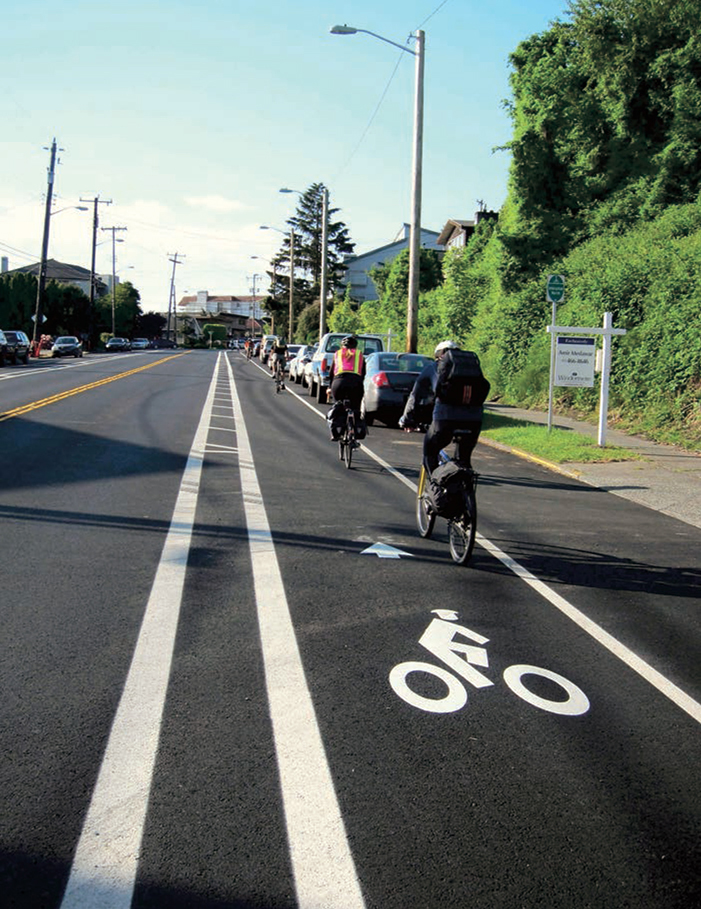
Buffered Bike Lanes

SEATTLE, WA
Buffered bike lanes are conventional bicycle lanes paired with a designated buffer space separating the bicycle lane from the adjacent motor vehicle travel lane and/or parking lane. A buffered bike lane is allowed as per MUTCD guidelines for buffered preferential lanes (section 3D–01).
Cyclists indicated they feel lower risk of being ‘doored’ in the buffered bike lanes and nearly nine in 10 cyclists preferred a buffered bike lane to a standard lane. Seven in 10 cyclists indicated they would go out of their way to ride on a buffered bike lane over a standard bike lane, ….
Portland State University, Center for Transportation Studies. (2011). Evaluation of Innovative Bicycle Facilities: SW Broadway Cycle Track & SW Stark/Oak Street Buffered Bike Lanes FINAL REPORT. Portland Bureau of Transportation, Portland, OR.
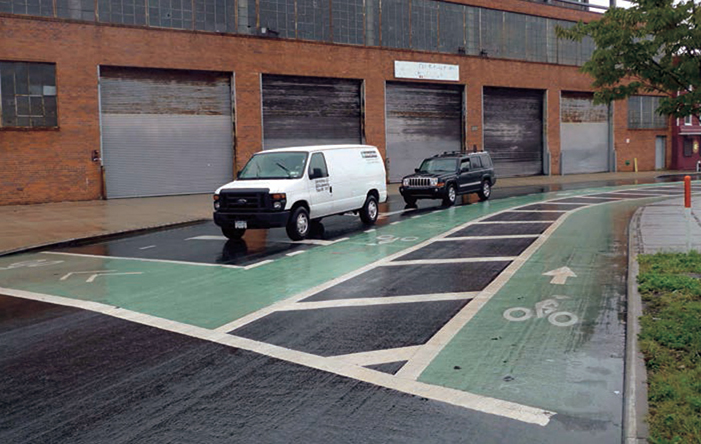
NEW YORK, NY

PHILADELPHIA, PA (PHOTO: PHILADELPHIA BICYCLE COALITION)
Benefits
Provides greater shy distance between motor vehicles and bicyclists.
Provides space for bicyclists to pass another bicyclist without encroaching into the adjacent motor vehicle travel lane.
Encourages bicyclists to ride outside of the door zone when buffer is between parked cars and bike lane.
Provides a greater space for bicycling without making the bike lane appear so wide that it might be mistaken for a travel lane or a parking lane.
Appeals to a wider cross-section of bicycle users.
Encourages bicycling by contributing to the perception of safety among users of the bicycle network.
Typical Applications
Anywhere a standard bike lane is being considered.
On streets with high travel speeds, high travel volumes, and/or high amounts of truck traffic.
On streets with extra lanes or extra lane width.
Special consideration should be given at transit stops to manage bicycle and pedestrian interactions.

CAPE CORAL, FL (PHOTO: WWW.PEDBIKEIMAGES.ORG, DAN MOSER)
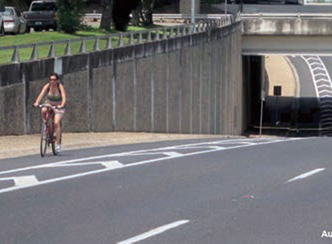
AUSTIN, TX
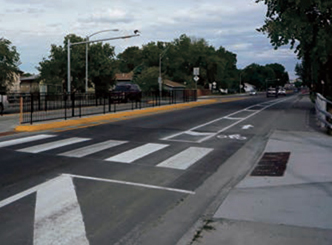
BILLINGS, MT
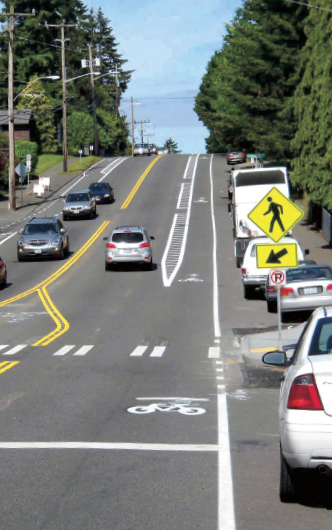
SEATTLE, WA
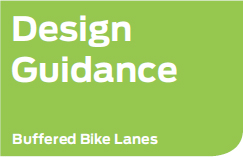
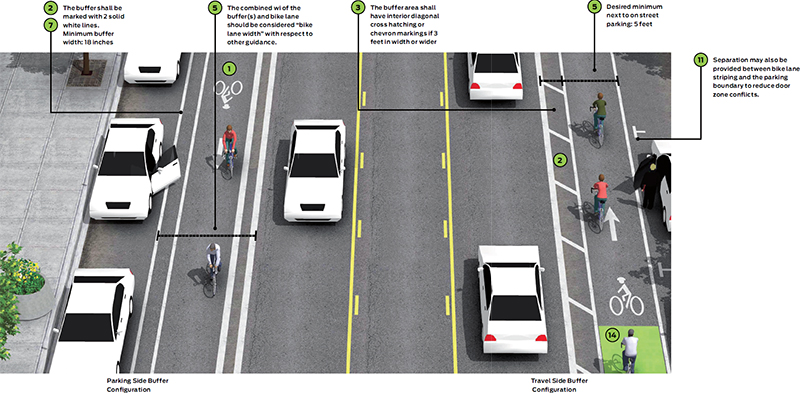
Required Features
 Bicycle lane word and/or symbol and arrow markings (MUTCD Figure 9C–3) shall be used to define the bike lane and designate that portion of the street for preferential use by bicyclists.9
Bicycle lane word and/or symbol and arrow markings (MUTCD Figure 9C–3) shall be used to define the bike lane and designate that portion of the street for preferential use by bicyclists.9
 The buffer shall be marked with 2 solid white lines, with diagonal hatching if 3 feet in width or wider. White lines on both edges of the buffer space indicate lanes where crossing is discouraged, though not prohibited. For clarity, consider dashing the buffer boundary where cars are expected to cross at driveways.10
The buffer shall be marked with 2 solid white lines, with diagonal hatching if 3 feet in width or wider. White lines on both edges of the buffer space indicate lanes where crossing is discouraged, though not prohibited. For clarity, consider dashing the buffer boundary where cars are expected to cross at driveways.10
 The buffer area shall have interior diagonal cross hatching or chevron markings if 3 feet in width or wider.11
The buffer area shall have interior diagonal cross hatching or chevron markings if 3 feet in width or wider.11
Recommended Features
 If used, interior diagonal cross hatching should consist of 4 inch lines angled at 30 to 45 degrees and striped at intervals of 10 to 40 feet. Increased striping frequency may increase motorist compliance.12
If used, interior diagonal cross hatching should consist of 4 inch lines angled at 30 to 45 degrees and striped at intervals of 10 to 40 feet. Increased striping frequency may increase motorist compliance.12
 The combined width of the buffer(s) and bike lane should be considered “bike lane width” with respect to guidance given in other documents that don’t recognize the existence of buffers. Where buffers are used, bike lanes can be narrower because the shy distance function is assumed by the buffer. For example, a 3 foot buffer and 4 foot bike lane next to a curb can be considered a 7 foot bike lane. For travel side buffered lanes next to on street parking, a 5 foot minimum width is recommended to encourage bicyclists to ride outside of the door zone.
The combined width of the buffer(s) and bike lane should be considered “bike lane width” with respect to guidance given in other documents that don’t recognize the existence of buffers. Where buffers are used, bike lanes can be narrower because the shy distance function is assumed by the buffer. For example, a 3 foot buffer and 4 foot bike lane next to a curb can be considered a 7 foot bike lane. For travel side buffered lanes next to on street parking, a 5 foot minimum width is recommended to encourage bicyclists to ride outside of the door zone.
 Where bicyclist volumes are high, bicyclist speed differentials are significant, or where side-by-side riding is desired, the desired bicycle travel area width is 7 feet.
Where bicyclist volumes are high, bicyclist speed differentials are significant, or where side-by-side riding is desired, the desired bicycle travel area width is 7 feet.
 Buffers should be at least 18 inches wide because it is impractical to mark a zone narrower than that.
Buffers should be at least 18 inches wide because it is impractical to mark a zone narrower than that.
 On intersection approaches with right turn only lanes, the bike lane should be transitioned to a through bike lane to the left of the right turn only lane, or a combined bike lane/turn lane should be used if available road space does not permit a dedicated bike lane.
On intersection approaches with right turn only lanes, the bike lane should be transitioned to a through bike lane to the left of the right turn only lane, or a combined bike lane/turn lane should be used if available road space does not permit a dedicated bike lane.
 On intersection approaches with no dedicated right turn only lane the buffer markings should transition to a conventional dashed line. Consider the use of a bike box at these locations.
On intersection approaches with no dedicated right turn only lane the buffer markings should transition to a conventional dashed line. Consider the use of a bike box at these locations.
Optional Features
 Like a conventional bike lane, a wide (6 to 8 inch) solid white line may be used to mark the edge adjacent to a motor vehicle travel lane. For a parking side buffer, parking T’s or a solid line are acceptable to mark between a parking lane and the buffer.
Like a conventional bike lane, a wide (6 to 8 inch) solid white line may be used to mark the edge adjacent to a motor vehicle travel lane. For a parking side buffer, parking T’s or a solid line are acceptable to mark between a parking lane and the buffer.
 For travel lane buffer configurations, separation may also be provided between bike lane striping and the parking boundary to reduce door zone conflicts. This creates a type of parking-side buffer.
For travel lane buffer configurations, separation may also be provided between bike lane striping and the parking boundary to reduce door zone conflicts. This creates a type of parking-side buffer.
 On wide one-way streets with buffered bike lanes, consider adding a buffer to the opposite side parking lane if the roadway appears too wide. This will further narrow the motor vehicle lanes and encourage drivers to maintain lower speeds.
On wide one-way streets with buffered bike lanes, consider adding a buffer to the opposite side parking lane if the roadway appears too wide. This will further narrow the motor vehicle lanes and encourage drivers to maintain lower speeds.
 The interior of the buffer area may use different paving materials to separate it from the bike lane. Textured surface materials may cause difficulties for bicyclists as surfaces may be rough. Increased maintenance requirements are likely.
The interior of the buffer area may use different paving materials to separate it from the bike lane. Textured surface materials may cause difficulties for bicyclists as surfaces may be rough. Increased maintenance requirements are likely.
 Color may be used at the beginning of each block to discourage motorists from entering the buffered lane. For other uses of color in buffered bike lanes see colored bike facilities.
Color may be used at the beginning of each block to discourage motorists from entering the buffered lane. For other uses of color in buffered bike lanes see colored bike facilities.
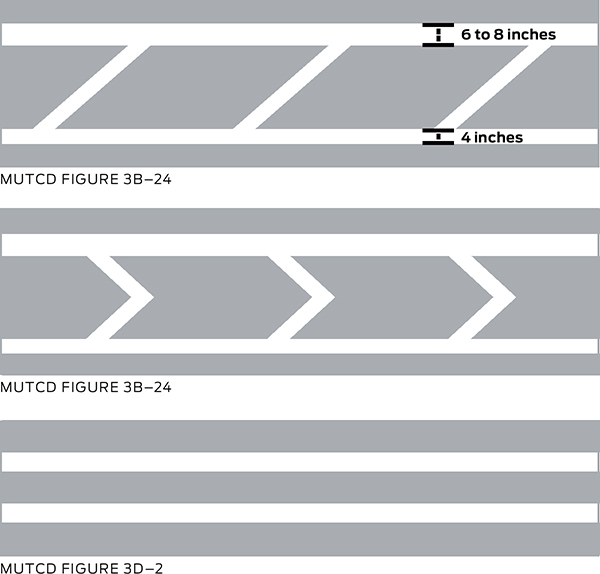
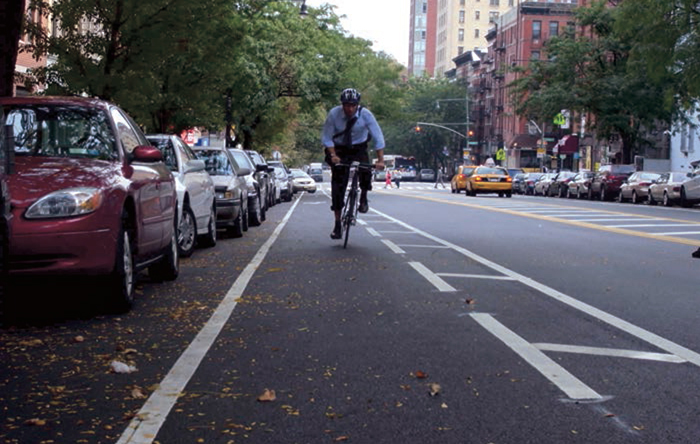
NEW YORK, NY
Maintenance
Buffer striping may require additional maintenance when compared to a conventional bicycle lane.
Buffered bike lanes should be maintained free of potholes, broken glass, and other debris.
If trenching is to be done in the bicycle lane, the entire bicycle lane should be trenched so that there is not an uneven surface or longitudinal joints.
See conventional bicycle lanes for additional maintenance issues that may apply.
Treatment Adoption and Professional Consensus
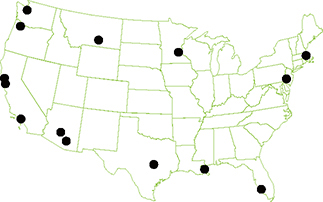
Buffered bike lanes are used in the following US cities and counties:
• Austin, TX
• Billings, MT
• Boston, MA
• Cape Coral, FL
• Los Angeles, CA
• Marin County, CA
• Minneapolis, MN
• New Orleans, LA
• New York, NY
• Philadelphia, PA
• Phoenix, AZ
• Portland, OR
• San Francisco, CA
• Seattle, WA
• Tucson, AZ